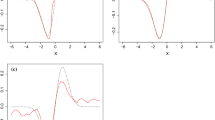Abstract
The asymptotic results that underlie applications of extreme random fields often assume that the variables are located on a regular discrete grid, identified with \(\mathbb {Z}^{2}\), and that they satisfy stationarity and isotropy conditions. Here we extend the existing theory, concerning the asymptotic behavior of the maximum and the extremal index, to non-stationary and anisotropic random fields, defined over discrete subsets of \(\mathbb {R}^{2}\). We show that, under a suitable coordinatewise mixing condition, the maximum may be regarded as the maximum of an approximately independent sequence of submaxima, although there may be high local dependence leading to clustering of high values. Under restrictions on the local path behavior of high values, criteria are given for the existence and value of the spatial extremal index which plays a key role in determining the cluster sizes and quantifying the strength of dependence between exceedances of high levels. The general theory is applied to the class of max-stable random fields, for which the extremal index is obtained as a function of well-known tail dependence measures found in the literature, leading to a simple estimation method for this parameter. The results are illustrated with non-stationary Gaussian and 1-dependent random fields. For the latter, a simulation and estimation study is performed.
Similar content being viewed by others
References
Adler, R.A.: The Geometry of Random Fields. Wiley, New York (1981)
Berman, S.: Sojourns and Extremes of Stochastic Processes. Taylor & Francis Ltd, USA (1992)
Choi, H.: Almost sure limit theorem for stationary Gaussian random fields. J. Korean Stat. Soc. 39, 475–482 (2010)
Cooley, D., Naveau, P., Poncet, P.: Variograms for spatial max-stable random fields. Lect. Notes Stat. 187, 373–390 (2006)
de Haan, L.: A spectral representation for max-stable processes. Ann. Probab. 12, 1194–1204 (1984)
Ferreira, M.: Estimating the extremal index through the tail dependence concept. Discussiones Mathematicae - Probab. Stat. 35, 61–74 (2015)
Ferreira, H., Pereira, L: How to compute the extremal index of stationary random fields. Stat. Probab. Lett. 78(11), 1301–1304 (2008)
Ferreira, M., Ferreira, H.: On extremal dependence of block vectors. Kybernetika 48(5), 988–1006 (2012)
Ferreira, H., Pereira, L.: Point processes of exceedances by random fields. J. Stat. Plan. Infer. 142(3), 773–779 (2012)
Krajina, A.: An M-Estimator of Multivariate Dependence Concepts. PhD Thesis. Tilburg, Tilburg University Press (2010)
Leadbetter, M.R., Lindgren, G., Rootzén, H: Extremes and Related Properties of Random Sequences and Processes. Springer, Berlin (1983)
Leadbetter, M.R., Nandagopalan, S.: On exceedance point process for stationary sequences under mild oscillation restrictions. In: Hüsler, J., Reiss, D (eds.) Extreme Value Theory: Proceedings, Oberwolfach, vol. 1987, pp 69–80. Springer, New York (1988)
Leadbetter, M.R., Rootzén, H.: On Extreme Values in Stationary Random Fields. Stochastic Processes and Related Topics, 275-285 Trends Math. Birkhauser, Boston (1998)
Li, H.: Orthant tail dependence of multivariate etreme value distributions. J. Multivar. Anal. 100(1), 243–256 (2009)
Pereira, L., Ferreira, H.: Limiting crossing probabilities of random fields. J. Appl. Probab. 3, 884–891 (2006)
Pereira, L.: On the extremal behavior of a non-stationary normal random field. J. Stat. Plan. Infer. 140(11), 3567–3576 (2010)
Piterbarg, V.I.: Asymptotics Methods in Theory of Gaussian Processes and Fields. Translations of Mathematical Monographs, vol. 48. American Mathematical Society (1996)
Schlather, M., Tawn, J.: A dependence measure for multivariate and spatial extreme values: Properties and inference. Biometrika 90, 139–156 (2003)
Sibuya, M.: Bivariate extreme statistics. Ann. Inst. Stat. Math. 11(2), 195–210 (1959)
Smith, R.L.: Max-Stable Processes and Spatial Extremes. Preprint Univ North Carolina, USA (1990)
Oliveira, J.T.: Structure theory of bivariate extremes: Extensions. Estudos de Matemática, Estatística e Econometria 7, 165–195 (1962/63)
Acknowledgments
We are grateful to the referees for their detailed comments and important suggestions which significantly improved this paper. This research was supported by National Foundation of Science and Technology through UID/MAT/00212/2013.
Author information
Authors and Affiliations
Corresponding author
Rights and permissions
About this article
Cite this article
Pereira, L., Martins, A.P. & Ferreira, H. Clustering of high values in random fields. Extremes 20, 807–838 (2017). https://doi.org/10.1007/s10687-017-0291-7
Received:
Revised:
Accepted:
Published:
Issue Date:
DOI: https://doi.org/10.1007/s10687-017-0291-7




